| 1. Raise right hand above head level with wand pointing up; move left-hand wand pointing down toward body. | Wingwalker/guide —This signal provides an indication by a person positioned at the aircraft wing tip, to the pilot/marshaller/ push-back operator, that the aircraft movement on/off a parking position would be unobstructed. | 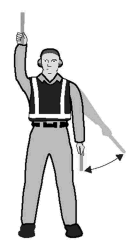 |
| 2. Raise fully extended arms straight above head with wands pointing up | Identify gate |  |
| 3. Point both arms upward, move and extend arms outward to sides of body and point with wands to direction of next signalman or taxi area. | Proceed to next signalman or as directed by tower/ground control |  |
| 4. Bend extended arms at elbows and move wands up and down from chest height to head. | Straight ahead |  |
| 5(a) With right arm and wand extended at a 90-degree angle to body, make “come ahead” signal with left hand. The rate of signal motion indicates to pilot the rate of aircraft turn. | Turn left (from pilot’s point of view) |  |
| 5(b) With left arm and wand extended at a 90-degree angle to body, make “come ahead” signal with right hand. The rate of signal motion indicates to pilot the rate of aircraft turn. | Turn right (from pilot’s point of view) |  |
| 6(a) Fully extend arms and wands at a 90-degree angle to sides and slowly move to above head until wands cross. | Normal stop | 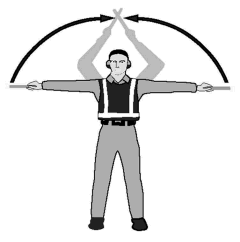 |
| 6(b) Abruptly extend arms and wands to top of head, crossing wands. | Emergency stop |  |
| 7(a) Raise hand just above shoulder height with open palm. Ensuring eye contact with flight crew, close hand into a fist. Do Not move until receipt of “thumbs up” acknowledgement from flight crew. | Set brakes |  |
| 7(b) Raise hand just above shoulder height with hand closed in a fist. Ensuring eye contact with flight crew, open palm. Do not move until receipt of “thumbs up” acknowledgement from crew. | Release brakes |  |
| 8(a) With arms and wands fully extending above head, move wands inwards in a “jabbing” motion until wands touch. Ensure acknowledgement is received from flight crew. | Chocks inserted |  |
| 8(b) With arms and wands fully extended above head, move wands outward in “jabbing” motion. Do not remove chocks until authorised by crew. | Chocks removed |  |
| 9. Raise right arm to head level with wand pointing up and start a circular motion with hand; at the same time, with left arm raised above head level, point to engine to be started. | Start engine(s) |  |
| 10. Extend arm with wand forward of body at shoulder level; move hand and want to top of left shoulder and draw wand to top of right shoulder in a slicing motion across throat. | Cut engine(s) |  |
| 11. Move extended arms downwards in a “patting” gesture, moving wands up and down from waist to knees. | Slow down |  |
| 12. With arms down and wands toward ground, wave either right or left wand up and down indicating engine(s) on left or right side respectively should be slowed down. | Slow down engine(s) on indicated side |  |
| 13. With arms in front of body at waist height, rotate arms in a forward motion. To stop rearward movement, use signal 6(a) or 6(b). | Move Back |  |
| 14(a) Point left arm with wand down and bring right arm from overhead vertical position to horizontal forward position, repeating right-arm movement. | Turns while backing (for tail to starboard) |  |
| 14(b) Point right arm with wand down and bring left arm from overhead vertical position to horizontal position, repeating left-arm movement. | Turns while backing (for tail to port) |  |
| 15. Raise right arm to head level with wand pointing up or display hand with “thumbs up”; left arm remains at side by knee. | Affirmative/all clear—This signal is also used as a technical/servicing communication signal. |  |
| 16. Fully extend arms and wands at a 90-degree angle to sides. | Hover |  |
| 17. Fully extend arms and wands at a 90-degree angle to sides and, with palms turned up, move hands upwards. Speed of movement indicates rate of ascent. | Move upwards |  |
| 18. Fully extend arms and wands at a 90-degree angle to sides and, with palms turned down, move hands downwards. Speed of movement indicates rate of descent. | Move downwards |  |
| 19(a) Extend arm horizontally at a 90-degree angle to right side of body. Move other arm in same direction in a sweeping motion. | Move horizontally left (from pilot’s point of view) |  |
| 19(b) Extend arm horizontally at a 90-degree angle to left side of body. Move other arm in same direction in a sweeping motion. | Move horizontally right (from pilot’s point of view) |  |
| 20. Cross arms with wands downwards and in front of body. | Land | 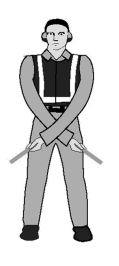 |
| 21. Move right-hand wand in a “fanning” motion from shoulder to knee, while at the same time pointing with left-hand wand to area of fire. | Fire |  |
| 22. Fully extend arms and wands downwards at a 45-degree angle to sides. Hold position until aircraft is clear for next manoeuvre. | Hold position/stand by |  |
| 23. Perform a standard salute with right hand and/or wand to dispatch the aircraft. Maintain eye contact with flight crew until aircraft has begun to taxi. | Dispatch aircraft |  |
| 24. Extend right arm fully above head and close fist or hold wand in horizontal position; left arm remains at side by knee. | Do not touch controls (technical/servicing communication signal) |  |
| 25. Hold arms fully extended above head, open left hand horizontally and move finger tips of right hand into a touch open palm of left hand (forming a “T”). At night, illuminated wands can also be used to form the “T” above head. | Connect ground power (technical/servicing communication signal) |  |
| 26. Hold arms fully extended above head with finger tips of right hand touching open horizontal palm of left hand (forming a “T”); then move right hand away from the left. Do not disconnect power until authorised by flight crew. At night illuminated wands can also be used to form the “T” above head. | Disconnect power (technical/servicing communication signal) |  |
| 27. Hold right arm straight out at 90 degrees from shoulder and point wand down to ground or display hand with “thumbs down”; left hand remains at side by knee. | Negative (technical/servicing communication signal) | 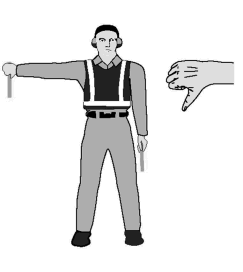 |
| 28. Extend both arms at 90 degrees from body and move hands to cup both ears. | Establish communication via interphone (technical/servicing communication signal) |  |
| 29. With right arm at side and left arm raised above head at a 45-degree angle, move right arm in a sweeping motion towards top of left shoulder. | Open/close stairs (technical/servicing communication signal)—This signal is intended mainly for aircraft with the set of integral stairs at the front | 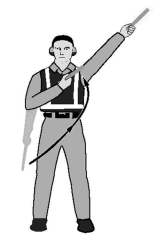 |


































